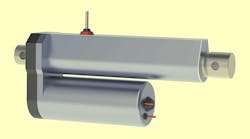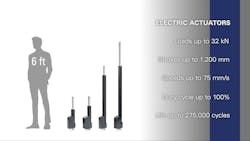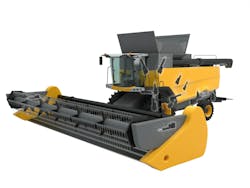The linear actuator market is forecast to experience significant growth in the coming years due in large part to their increased use in a range of applications and markets. A new report from Allied Market Research indicates the market for these actuators will achieve a compound annual growth rate (CAGR) of 6.05% through 2032.
This will lead to a projected revenue of $31.2 billion by 2032. According to the research firm, growth for the linear actuator market will be driven by increased implementation of automation in the manufacturing sector, advancements in robotics and the miniaturization of devices.
Linear actuators are known for their high repeatability and positioning accuracy which has helped them to be the actuator technology of choice for many applications. In automated manufacturing machinery and robotics especially, these capabilities are key to ensuring products are made correctly and in an efficient manner.
These and several other factors are expected to benefit the global linear actuator market over the next several years.
Why use of Linear Actuators is on the Rise
Linear actuators are devices which create motion in a straight line and are available in various types – pneumatic, hydraulic, electric, magnetic and thermal, and mechanical. Each offers various pros and cons and determining which to use for a given application is typically dependent on aspects such as force, response time and durability.
Features of linear actuators include their ability to stop at a fixed linear distance as well as high repeatability and positioning accuracy, all of which benefits their use in a range of applications such as food processing, automotive, material handling and more.
Linear actuators are also known for their ease of installation and operation, low maintenance and durability in harsh operating environments. These make them a suitable choice for pushing, pulling, lifting, and positioning, among other tasks.
Given the many benefits offered by this type of actuator and the many applications in which they can be used, their use has been growing. There have also been many technological advancements taking place in recent years for these actuators, further enhancing their capabilities and use cases.
According to Allied Market Research, the ability to use linear actuators for automated movements is a key driver for their continued growth. They provide the versatility and exactness needed for automated tasks, the research firm said, and it’s possible to remotely control and customize these actuators to further benefit various application needs.
However, the research firm noted in its report that advanced linear actuators used in automation or control systems can require specialized knowledge and maintenance which creates some complexity – and potential headwinds for their continued market uptake. The rapid rate of technological innovation related to these actuators poses challenges as well by making it difficult for end users to keep up with the latest and greatest.
But in general, the rate of adoption for linear actuators will remain positive because of the many benefits they can offer, especially when it comes to providing the precision and control desired by the increasing number of automated systems in just about every industry.
Applications and Regions with Highest Potential for Linear Actuators
In its report, Allied Market Research breaks the linear actuator market into five key end-use industries:
- Automotive
- Construction
- Energy and Mining
- Healthcare
- Others.
The automotive sector is currently forecast to provide the most growth opportunity. In 2022, it accounted for close to one-third of the market share for linear actuators. From 2023 to 2032 it is expected to see the fastest CAGR of 6.92% per the research firm’s report.
Driving growth for this end-use industry is increased use of automation for the manufacture of vehicles as well as integration of advanced technologies into the vehicles themselves – including the transition to electrification and autonomous driving.
According to Allied Market Research, the precise control and efficiency provided by linear actuators benefits each of these trends and is thus helping drive their uptake in this sector.
Construction is noted as the next highest growth opportunity industry for linear actuators. Infrastructure investments around the world are expected to keep demand for construction equipment, which typically makes use of hydraulic actuators, high over the next several years. The transition to electrification and automation in this sector will likely necessitate increased use of linear actuators as well.
In its analysis of the global linear actuator market, Allied Market Research found there are several regions where this market will see growth opportunities in the future. It noted Asia-Pacific had the highest revenue in 2022 of the global markets, and is expect to achieve the fastest CAGR through 2032 of 6.98%. This is due to its economy being heavily focused on the manufacturing sector which is rapidly adopting automation solutions.
Automation in other sectors will benefit the Asia-Pacific linear actuator market as well; use of the technology in healthcare and electric vehicles will also aid growth in this region according to the research firm’s report.
In North America, the U.S. has gained a large part of the market share for linear actuators. Allied Market Research said this is due to the country’s technical infrastructure, substantial industrial sectors and emphasis on automation and innovation, all of which are driving use of linear actuators.
Germany, China and Latin America are also regions with high growth potential for the market due to their investments in automation and other technological updates for the industrial and other sectors.
Electric Actuators to Drive Market Growth
Allied Market Research is projecting growth for all linear actuator types – electric, hydraulic and pneumatic. However, the electric actuator segment of the market is expected to offer the most growth potential through 2032.
Per the research firm, the electric linear actuator segment accounted for two-fifths of the global market’s revenue in 2022. It will continue to dominate the linear actuator market with a CAGR of 6.88% expected from 2023-2032.
Automation, technology advancements and a shift to more energy-efficient solutions are drivers for the increasing use of electric linear actuators.
Hydraulic and pneumatic actuators have been the option used in many heavy-duty applications. And while they still have their place in many – such as construction equipment and other mobile machinery – advancements in electric options are enabling them to become a viable alternative which is better able to meet the automation and efficiency needs of some applications.
Thomson Industries Inc., a developer of linear motion control solutions, sees the market shifting toward more use of electric linear actuators because of the many benefits they can provide over fluid power-based versions.
Some of the challenges posed by hydraulic and pneumatic actuators include complexity, noise, high energy consumption, safety concerns and adverse environmental impacts. According to Thomson, electric actuators are able to overcome many of these as they feature a compact design, simplified wiring and are fluid free – eliminating the risk of leaks which can be a safety concern for both humans and the environment.
In addition, electric actuator technology has reached a point where it is capable of providing load handling on par with hydraulic systems which is enabling its use in more applications. Advanced controls and diagnostics can also be integrated into electric linear actuators, enabling better communication with other machines and systems as well as monitoring of performance to mitigate unplanned downtime.
Watch Thomson’s video about electric linear actuators enabling electrification of various applications.
In an interview with Power & Motion, Tom Diedrichs, Product Manager Actuators at Ewellix, he stated that different sectors and applications are at differing maturity levels when it comes to use of electric actuators. Healthcare, for instance, is an almost fully mature market where it is less common to find hydraulic or pneumatic technologies.
But the heavy-duty mobile equipment industry, where hydraulics in particular remain the dominant technology of choice, is in the early stages of adopting electric actuators. Diedrichs said there are some work functions on these machines which are making use of electric actuators. And concept electric machines from Bobcat have shown the ability to completely remove the hydraulics system and instead use an electrified power system with electric actuators for work functions.
Future Market Insights is projecting the global electric linear actuator market will grow at a 5.3% CAGR through 2032, reaching a value of $34.3 billion.
There will of course be instances where hydraulic or pneumatic options will continue to be the preferred choice or where use of electric actuators is not yet feasible, such as excavators. As such, opportunities will remain for all actuator types in the coming years.
In its report, Allied Market Research pointed to pneumatic options being the second highest growth driver for the linear actuator market followed by hydraulics. This is likely due to the ongoing investments in nearshoring and reshoring taking place around the world as pneumatic technologies are more often used with manufacturing and production machinery, even those which use automation solutions.
Overall, there are many opportunities ahead for the global linear actuator market.
Visit our State of the Industry channel for more market insights related to hydraulic, pneumatic and electric motion control technologies.






